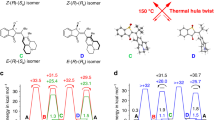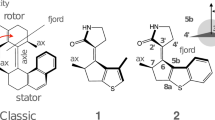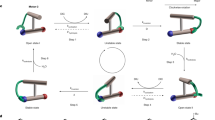Abstract
Biological rotary motors can alter their mechanical function by changing the direction of rotary motion. Achieving a similar reversal of direction of rotation in artificial molecular motors presents a fundamental stereochemical challenge: how to change from clockwise to anticlockwise motion without compromising the autonomous unidirectional rotary behaviour of the system. A new molecular motor with multilevel control of rotary motion is reported here, in which the direction of light-powered rotation can be reversed by base-catalysed epimerization. The key steps are deprotonation and reprotonation of the photochemically generated less-stable isomers during the 360° unidirectional rotary cycle, with complete inversion of the configuration at the stereogenic centre. The ability to change directionality is an essential step towards mechanical molecular systems with adaptive functional behaviour.
This is a preview of subscription content, access via your institution
Access options
Subscribe to this journal
Receive 12 print issues and online access
$259.00 per year
only $21.58 per issue
Buy this article
- Purchase on Springer Link
- Instant access to full article PDF
Prices may be subject to local taxes which are calculated during checkout







Similar content being viewed by others
References
Schliwa, M. Molecular Motors (Wiley-VCH, 2003).
Kay, E. R., Leigh, D. A. & Zerbetto, F. Synthetic molecular motors and mechanical machines. Angew. Chem. Int. Ed. 46, 72–191 (2007).
Balzani, V., Credi, A., Raymo, F. M. & Stoddart, J. F. Artificial molecular machines. Angew. Chem. Int. Ed. 39, 3348–3391 (2000).
Stoddart, J. F. Molecular machines. Acc. Chem. Res. 34, 410–411 (2001).
Jiménez, M. C., Dietrich-Buchecker, C. & Sauvage, J. P. Towards synthetic molecular muscles: contraction and stretching of a linear rotaxane dimer. Angew. Chem. Int. Ed. 39, 3284–3287 (2000).
Feringa, B. L. The art of building small: from molecular switches to molecular motors. J. Org. Chem. 72, 6635–6652 (2007).
De Rosier, D. J. The turn of the screw: the bacterial flagellar motor. Cell 93, 17–20 (1998).
Kinosita, K., Yasuda, R., Noji, H., Ishiwata, S. & Yoshida, M. F1-ATPase: a rotary motor made of a single molecule. Cell 93, 21–24 (1998).
Vale, R. D. & Milligan, R. A. The way things move: looking under the hood of molecular motor proteins. Science 288, 88–95 (2000).
Mahadevan, L. & Matsudaira, P. Motility powered by supramolecular springs and ratchets. Science 288, 95–99 (2000).
van den Heuvel, M. G. L. & Dekker, C. Motor proteins at work for nanotechnology. Science 317, 333–336 (2007).
Kinbara, K. & Aida, T. Toward intelligent molecular machines: directed motions of biological and artificial molecules and assemblies. Chem. Rev. 105, 1377–1400 (2005).
Sauvage, J.-P. & Dietrich-Buchecker, C. (eds.) Molecular Catenanes, Rotaxanes and Knots (Wiley-VCH, 1999).
Koumura, N., van Delden, R. A., ter Wiel, M. K. J. & Feringa, B. L. Light-driven molecular switches and motors. Appl. Phys. A 75, 301–308 (2002).
van Delden, R. A., Koumura, N., Geertsema, E. M. & Feringa, B. L. Chiroptical molecular switches. Chem. Rev. 100, 1789–1816 (2000).
Feringa, B. L. (ed.) Molecular Switches (Wiley-VCH, 2001).
Browne, W. R. & Feringa, B. L. Making molecular machines work. Nature Nanotech. 1, 25–35 (2006).
Purcell, E. M. Life at low Reynolds number. Am. J. Phys. 45, 3–11 (1977).
Klok, M. et al. MHz unidirectional rotation of molecular rotary motors. J. Am. Chem. Soc. 130, 10484–10485 (2008).
Pollard, M. M., Philana, V. W., Pijper, D. & Feringa, B. L. On the effect of donor and acceptor substituents on the behaviour of light-driven rotary molecular motors. Org. Biomol. Chem. 6, 1605–1612 (2008).
Pollard, M. M., Meetsma, A. & Feringa, B. L. A redesign of light-driven rotary molecular motors. Org. Biomol. Chem. 6, 507–512 (2008).
Fletcher, S. P., Dumur, F., Pollard, M. M. & Feringa, B. L. A reversible, unidirectional molecular rotary motor driven by chemical energy. Science 310, 80–82 (2005).
Lin, Y., Dahl, B. J. & Branchaud, B. P. Net directed 180° aryl–aryl bond rotation in a prototypical achiral biaryl lactone synthetic molecular motor. Tetrahedron Lett. 46, 8359–8362 (2005).
Kelly, T. R., Silva, H. D. & Silva, R. A. Unidirectional rotary motion in a molecular system. Nature 401, 150–152 (1999).
Leigh, D. A., Wong, J. K. Y., Dehez, F. & Zerbetto, F. Unidirectional rotation in a mechanically interlocked molecular rotor. Nature 424, 174–179 (2003).
Hernández, J. V., Kay, E. R. & Leigh, D. A. A reversible synthetic rotary molecular motor. Science 306, 1532–1537 (2004).
Saha, S. et al. A redox-driven multicomponent molecular shuttle. J. Am. Chem. Soc. 129, 12159–12171 (2007).
Koumura, N., Geertsema, E. M., van Gelder, M. B., Meetsma, A. & Feringa, B. L. Second generation light-driven molecular motors. Unidirectional rotation controlled by a single stereogenic center with near-perfect photoequilibria and acceleration of the speed of rotation by structural modification. J. Am. Chem. Soc. 124, 5037–5051 (2002).
Pollard, M. M., Klok, M., Pijper, D. & Feringa, B. L. Rate acceleration of light-driven rotary molecular motors. Adv. Funct. Mater. 17, 718–729 (2007).
van Delden, R. A. et al. Unidirectional molecular motor on a gold surface. Nature 437, 1337–1340 (2005).
Pollard, M. M., Lubomska, M., Rudolf, P. & Feringa, B. L. Controlled rotary motion in a monolayer of molecular motors. Angew. Chem. Int. Ed. 46, 1278–1280 (2007).
Eelkema, R. et al. Rotational reorganization of doped cholesteric liquid crystalline films. J. Am. Chem. Soc. 128, 14397–14407 (2006).
Eelkema, R. et al. Molecular machines: nanomotor rotates microscale objects. Nature 440, 163 (2006).
Pijper, D, Jongejan, M. G. M., Meetsma, A. & Feringa, B. L. Light-controlled supramolecular helicity of a liquid crystalline phase using a helical polymer functionalized with a single chiroptical molecular switch. J. Am. Chem. Soc. 130, 4541–4552 (2008).
Pijper, D. & Feringa, B. L. Molecular transmission: controlling the twist sense of a helical polymer with a single light-driven molecular motor. Angew. Chem. Int. Ed. 46, 3693–3696 (2007).
van Delden, R. A., ter Wiel, M. K. J., de Jong, H., Meetsma, A. & Feringa, B. L. Exploring the boundaries of a light-driven molecular motor design: new sterically overcrowded alkenes with preferred direction of rotation. Org. Biomol. Chem. 2, 1531–1541 (2004).
Okubo, T., Yoshikawa, R., Chaki, S., Okuyama, S. & Nakazato, A. Design, synthesis, and structure–activity relationships of novel tetracyclic compounds as peripheral benzodiazepine receptor ligands. Bioorg. Med. Chem. 12, 3569–3580 (2004).
McWatt, M. & Boons, G. J. Parallel combinatorial synthesis of glycodendrimers and their hydrogelation properties. Eur. J. Org. Chem. 2535–2545 (2001).
Barton, D. H. R. & Willis, B. J. Olefin synthesis by two-fold extrusion processes. Part I preliminary experiments. J. Chem. Soc. Perkin Trans. 1 3, 305–310 (1972).
Buter, J., Wassenaar, S. & Kellogg, R. M. Thiocarbonyl ylides: generation, properties, and reactions. J. Org. Chem. 37, 4045–4060 (1972).
Paquette, L. A. Encyclopedia of Reagents for Organic Synthesis (Wiley, 1995) 6, 3982.
Geertsema, E. M., van der Molen, S. J., Martens, M & Feringa, B. L. Optimizing rotary processes in synthetic molecular motors. Proc. Natl Acad. Sci. USA 106, 16919–16924 (2009).
Acknowledgements
We thank the Netherlands Organization for Scientific Research, the Zernike Institute for Advanced Materials, the European Research Council (advanced grant no: 227897) and the University of Groningen for financial support.
Author information
Authors and Affiliations
Contributions
N.R. and M.M.P. carried out the experimental work. All the authors contributed to the design of the experiments, the analysis of the data and the writing of the paper.
Corresponding author
Ethics declarations
Competing interests
The authors declare no competing financial interests.
Supplementary information
Supplementary information
Supplementary information (PDF 2075 kb)
Rights and permissions
About this article
Cite this article
Ruangsupapichat, N., Pollard, M., Harutyunyan, S. et al. Reversing the direction in a light-driven rotary molecular motor. Nature Chem 3, 53–60 (2011). https://doi.org/10.1038/nchem.872
Received:
Accepted:
Published:
Issue Date:
DOI: https://doi.org/10.1038/nchem.872
This article is cited by
-
Manipulating the rotation modes by electricity and light based on the second-generation molecular motor
Applied Physics A (2022)
-
Dual-light control of nanomachines that integrate motor and modulator subunits
Nature Nanotechnology (2017)
-
A light-powered clockwork
Nature Nanotechnology (2017)
-
A volumetric three-dimensional digital light photoactivatable dye display
Nature Communications (2017)
-
On the possibility to accelerate the thermal isomerizations of overcrowded alkene-based rotary molecular motors with electron-donating or electron-withdrawing substituents
Journal of Molecular Modeling (2016)



